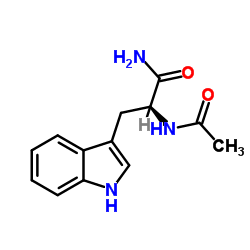AC-TRP-NH2

AC-TRP-NH2 structure
|
Common Name | AC-TRP-NH2 | ||
|---|---|---|---|---|
| CAS Number | 2382-79-8 | Molecular Weight | 245.28 | |
| Density | 1.3±0.1 g/cm3 | Boiling Point | 636.4±55.0 °C at 760 mmHg | |
| Molecular Formula | C13H15N3O2 | Melting Point | 194-196ºC(lit.) | |
| MSDS | Chinese USA | Flash Point | 338.7±31.5 °C | |
|
Freezing-induced perturbation of tertiary structure of a monoclonal antibody.
J. Pharm. Sci. 103(7) , 1979-86, (2014) We studied the effects of pH and solution additives on freezing-induced perturbations in the tertiary structure of a monoclonal antibody (mAb) by intrinsic tryptophan fluorescence spectroscopy. In general, freezing caused perturbations in the tertiary structu... |
|
|
QSAR study on permeability of hydrophobic compounds with artificial membranes.
Bioorg. Med. Chem. 15 , 3756-67, (2007) We previously reported a classical quantitative structure-activity relationship (QSAR) equation for permeability coefficients (P(app-pampa)) by parallel artificial membrane permeation assay (PAMPA) of structurally diverse compounds with simple physicochemical... |
|
|
Single tryptophan mutants of FtsZ: nucleotide binding/exchange and conformational transitions.
Biochim. Biophys. Acta 1844(7) , 1193-200, (2014) Cell division protein FtsZ cooperatively self-assembles into straight filaments when bound to GTP. A set of conformational changes that are linked to FtsZ GTPase activity are involved in the transition from straight to curved filaments that eventually disasse... |
|
|
Molecular Events in Lamin B1 Homopolymerization: A Biophysical Characterization.
J. Phys. Chem. B 119 , 14014-21, (2015) Lamin B1 is one of the major constituents of the nuclear lamina, a filamentous network underlying the nucleoplasmic side of the inner nuclear membrane. Homopolymerization of lamin B1, coupled to the homotypic and heterotypic association of other lamin types, ... |
|
|
Tryptophan probes reveal residue-specific phospholipid interactions of apolipoprotein C-III.
Biochim. Biophys. Acta 1848 , 2821-8, (2015) Apolipoproteins are essential human proteins for lipid metabolism. Together with phospholipids, they constitute lipoproteins, nm to μm sized particles responsible for transporting cholesterol and triglycerides throughout the body. To investigate specific prot... |
|
|
Solubilities and transfer free energies of hydrophobic amino acids in polyol solutions: importance of the hydrophobicity of polyols.
J. Pharm. Sci. 100(8) , 3096-104, (2011) The purpose of this work was to investigate the difference in the hydrophobicities of various polyols and the nature of interactions between hydrophobic amino acid side chains and polyols. The interactions were explored by conducting solubility studies of thr... |
|
|
Metal-enhanced Intrinsic Fluorescence of Proteins on Silver Nanostructured Surfaces towards Label-Free Detection.
J. Phys. Chem. C Nanomater. Interfaces 112 , 17957-17963, (2008) In recent years metal-enhanced fluorescence (MEF) using silver particles has been reported for a number of fluorophores emitting at visible wavelengths. However it was generally thought that silver particles would always quench fluorescence at shorter wavelen... |
|
|
Peptide sequence and conformation strongly influence tryptophan fluorescence.
Biophys. J. 94 , 2280-2287, (2008) This article probes the denatured state ensemble of ribonuclease Sa (RNase Sa) using fluorescence. To interpret the results obtained with RNase Sa, it is essential that we gain a better understanding of the fluorescence properties of tryptophan (Trp) in pepti... |
|
|
Biophysical characterization, including disulfide bond assignments, of the anti-angiogenic type 1 domains of human thrombospondin-1.
Biochemistry 41(48) , 14329-39, (2002) Thrombospondin-1 (TSP1), a modular secreted glycoprotein, possesses anti-angiogenic activity both in vitro and in vivo. This activity has been localized to the thrombospondin type 1 repeats/domains (TSR). A TSP1 monomer contains three TSRs, each with a hydrop... |
|
|
A deoxygenation system for measuring protein phosphorescence.
Anal. Biochem. 324(1) , 106-14, (2004) An inexpensive and quick deoxygenation system for measuring protein phosphorescence is described. Oxygen was first reduced to less than 1 ppb from nitrogen or other inert gas by passing through an oxygen trap. The oxygen-free gas was routed through stainless ... |